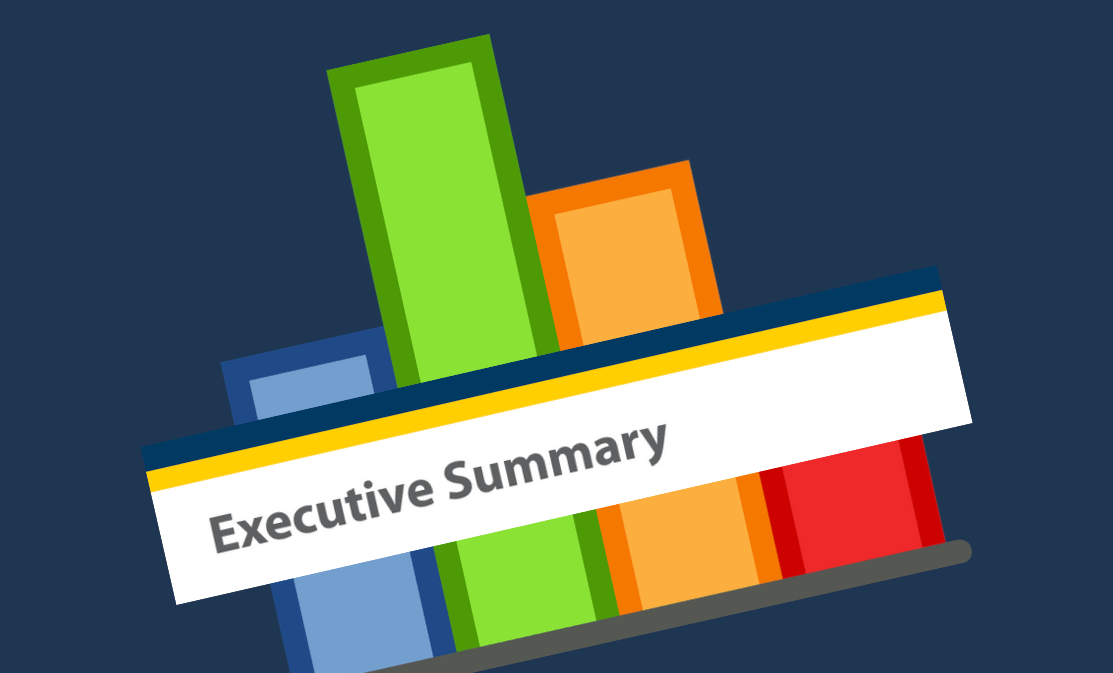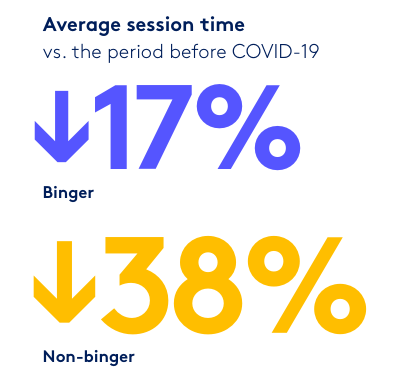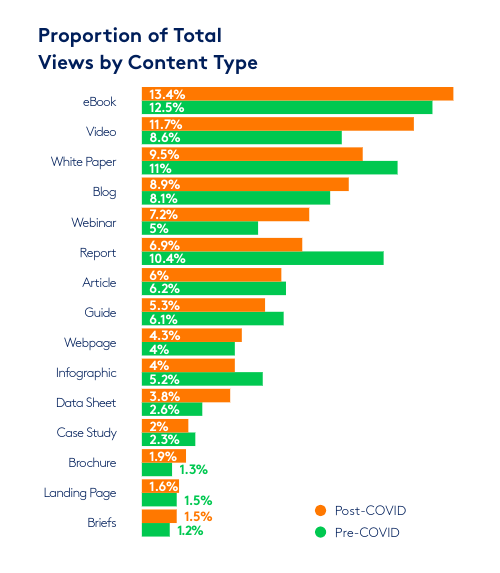Hungry for B2B Cybersecurity Content
New research shows that B2B buyers and customers in the US engage with more content more often during the pandemic. What does this mean for cybersecurity content marketing?

New research from content platform provider PathFactory reveals a massive increase in B2B marketing content consumption following the first lockdowns related to COVID-19 in the US.
Average session times, on the other hand, saw a significant decrease. During the same period, the engagement with B2B cybersecurity content was almost as strong on average (4:20 min.) as with COVID-19 topics (4:50 min), which top the list.
The findings, derived from data collected from hundreds of enterprises and mid-market technology companies, are now available in a research report titled Content Engagement Report: How COVID-19 changed B2B content consumption in 2020.
Note the dramatic increase in attention paid to IT security-related B2B content. Market observers attribute this to the shift to remote work and the increase in cybersecurity risks that come with it.
This leaves the question what content asset types actually lived up to the task.
What content types do buyers prefer?
In cybersecurity content marketing, what B2B content formats and assets are worth a second look? The new report provides critical pointers.
According to PathFactory, the most-viewed content asset types during the pandemic include webinars, videos, eBooks, and reports. Like before the COVID-19 crisis, eBooks account for the most significant share of total views.
The content format with the largest engagement increase are executive summaries, according to the PathFactory study.
Engagement with executive summaries was up 256.6% compared to the period before COVID-19. To put that in perspective: B2B landing pages saw "only" a 139.5% increase.
More B2B cybersecurity content. But does it stick?
The most-viewed content asset types during the pandemic include webinars (consumption up 128.1%), reports (up 65.1%), and videos (up 27%), reports PathFactory.
Other noteworthy findings from the report include:
- During the pandemic, 17% more visitors accessed B2B digital content, unique asset views were up 40%, and visitors spent 15% more time reading and viewing what they found.
- Site visitors interacted with more B2B content, more often: there was a 42% increase in sessions.
- Yet those sessions were 17% shorter for "bingers" (visitors who engaged with more than one asset in a single session) and 38% shorter for "non-bingers".

Source: PathFactory
What do these results mean for B2B cybersecurity content marketing?
How COVID-19 changed B2B cybersecurity content marketing
The cybersecurity industry has ramped up its B2B content marketing during the pandemic. Your company is focusing on webinars, webcasts, videos, and podcasts? So are your competitors.
At the same time, B2B buyers overall spend less time with more IT security content marketing assets clamoring for their attention.
What are they looking for? "Unknowns looked for content credibility, known visitors wanted actionable next steps," the PathFactory report points out.
The pandemic is putting immense burdens on IT, cybersecurity, and compliance technology leaders. It's fair to assume that this particular group's session times are down by even more than 38%.
That means you cannot rely on them patiently sitting through even the most relevant and instructive webinars, webcasts, videos, or cybersecurity podcasts.
They dip in, dip out, and move on.
Based on the new research data, what content should you custom-tailor for this situation?
One answer almost jumps out from the report: executive summaries of webinars and webcasts.

Increase in content consumption by asset type (excerpt)
Source: PathFactory
How to write executive summaries of webinars for cybersecurity buyers?
Research shows that executive summaries of webcasts and webinars deserve more attention in content marketing. Cybersecurity content leaders, read the signs.
Do you want all the efforts your team put into webinars and webcasts to make a dent? Distill them into executive summaries that are custom-tailored to the needs and tight schedules of IT security leaders and C-level executives.
Repurpose your video, audio, and slides for those time-constrained "non-bingers" on a mission. Help them accomplish their mission faster.
Present them with an executive summary of the recording that condenses 30, 45, or 60 minutes (including Q&A) into 2-6 pages. Provide an at-a-glance overview of the main takeaways that is efficiently structured, easy on the eye, and includes actionable next steps.
As a rule of thumb, reading an executive summary should take no more than 10% of the time it would take to watch the webinar or webcast. For a 60-minute production, plan for a maximum of 1,800 words = six minutes at average reading speed.
So, who's writing it?
How to repurpose digital event content without "cheapening" it
Are your company's content writers over capacity? Before you assign the task to a digital events coordinator or your favorite gig marketplace, a word of caution.
Readers expect this format to save them (or their higher-ups) valuable time. They are looking for a quick and effortless read, concise and to the point.
Writing executive summaries is not a task you want to assign to junior content writers on the team or to a subject matter expert involved with the original presentation or panel.
They may know too little or "too much," respectively, to present the gist of the matter in the language, style, and format that readers expect.
Nor is this task something you want to outsource to a random freelancer or an overseas content mill, given the industry lingo of cybersecurity web events. They often involve technical deep-dives and in-depth cyber threat research discussions.

Source: PathFactory
Industry outsiders frequently struggle to accurately excerpt and capture the essence of cybersecurity audio or video transcripts.
Most transcripts for this purpose are automatically generated. They reflect the infamous abundance of acronyms and abbreviations in the cybersecurity sector, interspersed with misspellings (example: "sock leader" instead of "SOC leader").
Clean-up efforts by writers or external editors who are not sufficiently familiar with the subject area tend to introduce more misunderstandings.
"Unknowns looked for content credibility"
Such mistakes will add to your internal content team's workload or, if you miss them, diminish the content's credibility and leave readers less inclined to take the next step.
As the PathFactory report points out, content credibility is key to engaging new visitors (the "unknowns") with whom dialog has not been established yet.
This is especially true for site visitors vetting cybersecurity vendors for their competence and trustworthiness.
Another recent research report, presented by Hinge Marketing: Inside the Buyer's Brain: How You Can Adapt to Shifting Buyer Behavior, shows what B2B buyers are looking for: In 2020, they put the highest value on knowledge of the industry/subject matter expertise (32.2%), up 56% since 2018 (20.6%).
In cybersecurity marketing, executive summaries of webinars and webcasts are a cost-effective way to repurpose digital event programs with content that highlights core competencies, adds credibility, and builds trust.
Did your company host webcasts or webinars over the past months? Extend their shelf life and increase their impact. Contact use now to convert them into executive summaries:
